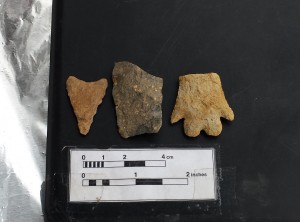
CCB MEDIA PHOTOS
Stone points uncovered during the Taylor-Bray Farm archaeological project this fall. A Paleo-Indian point, middle, could be over 10,000 years old. A bifurcate base point, right, could be 8,000 to 10,000 years old.
YARMOUTHPORT – The first day of a local archaeological dig uncovered some noteworthy artifacts.
Volunteers for the archaeological project at the Taylor-Bray Farm in Yarmouthport found two stone points last week that could be from 8,000 to over 10,000 years old.
Craig Chartier, the lead archaeologist for the project, said the find is significant for the region.
“As a result of the excavations that we have done here, we have pushed the dates of occupation in this area of Yarmouth and this part of Cape Cod all the way back to, potentially, 10,000 years,” he said.
Chartier said one of the artifacts is believed to be an 8,000- to 10,000-year-old bifurcate base point, and the other, which could be older than 10,000 years old, is a paleoindian point.
The bifurcate base point was found first by a couple volunteers and minutes later the paleoindian point was discovered.
Local archaeologist Dan Zoto, who has been working on the Taylor-Bray Farm project for the last few years, said the find is rare.
“I’ve dug well over 100 sites and I’ve never seen those artifacts of that age come out of the ground, so that was very exciting,” Zoto said.
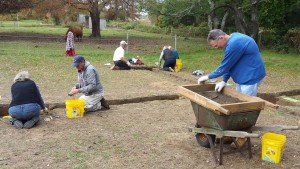
James Kyrimes, right, sifts through soil as volunteers work at the dig on Wednesday.
Zoto said these types of artifacts usually aren’t found in this region of the country and when they are recovered it is usually a surface find and not from under the ground.
The focus for the dig this fall was pre-colonial Native American activities at the farm.
“It adds an entirely new dimension to the history of the town of Yarmouth,” said Jack Duggan, archaeological coordinator of the Taylor-Bray Farm Preservation Association. “Everybody knows that there was a Native American population here particularly in the Bass River area, but this area in the north part of Yarmouthport is sort of virgin territory, archaeologically speaking.”
The project is a community dig and Chartier said there are about 40 people who have signed up to volunteer. The dig consists of two shifts during the day, from 9 a.m. to noon and 1 to 4 p.m., and each shift usually has about 10 to 12 volunteers.
One of the volunteers is Dennis resident James Kyrimes, who is in his fourth year with the project and is a member of the Taylor-Bray Farm Preservation Association.
“Archaeology is somewhat addictive,” Kyrimes said. “I’m looking for the jackpot.”
Kyrimes said once some kind of treasure trove is found, it’s all about finding the next one.
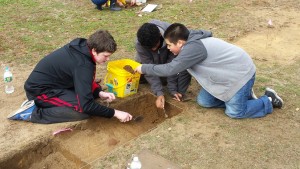
Eighth grade students working at the dig on Wednesday including Max Walsh, left, Troy Johnson, middle, and Noah Shenk, right.
High school students are also taking part in the dig. Cliff Miller, a history teacher at Dennis-Yarmouth Regional High School, brings his 8th grade students to the dig for three days.
“They are going through the whole process of the dig, the details about it and how they record everything,” Miller said. “And they are learning about the local history of the farm.”
Miller said the feedback he gets from the students is all positive.
“I see the kids when they are seniors and they say ‘remember the dig, Mr. Miller,’” he said. “So they like it. They remember it.”
Student Noah Shenk said participating in the dig on the farm is exciting.
“It’s pretty amazing because it doesn’t really get used that much now, but back then it was a hub for local groups who were using this land for survival,” Shenk said.
The archaeological project at the farm started in 2009 when volunteers discovered artifacts below the floorboards of the 18th century farm house.
Native American artifacts found at the site indicate a seasonal use of the property.
Workers on the dig last fall discovered post hole soil features that show the exact location of the original 17th century Taylor farm house.
The dig this fall is expected to last through early November.
By BRIAN MERCHANT, CapeCod.com NewsCenter






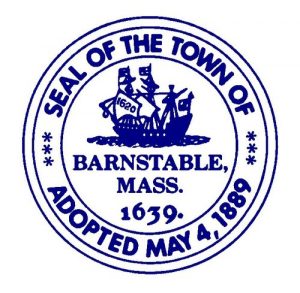
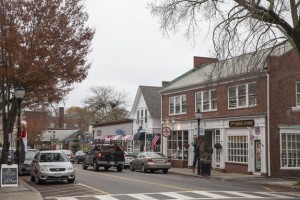
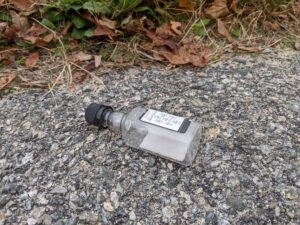


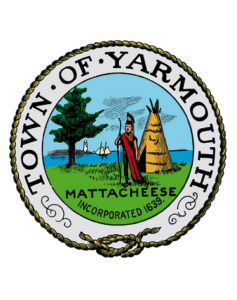
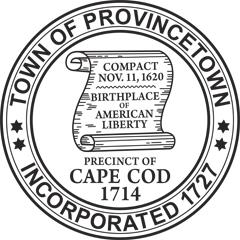
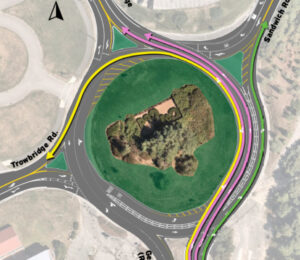











Are they worth any money